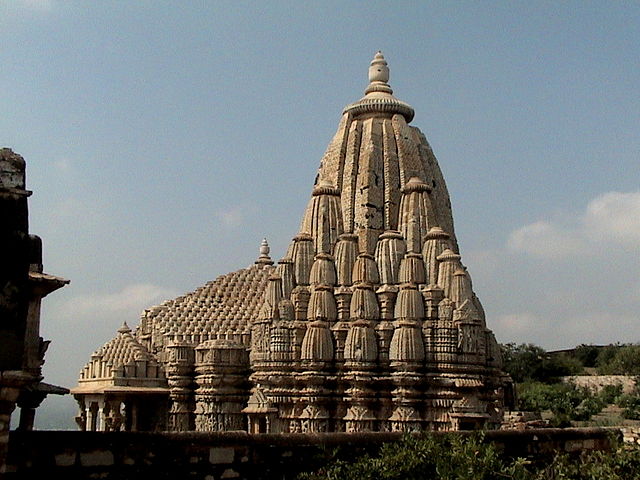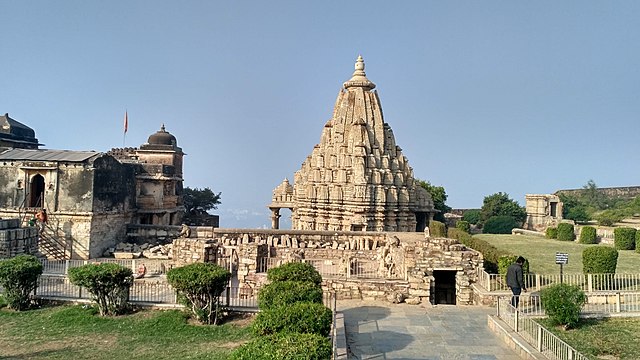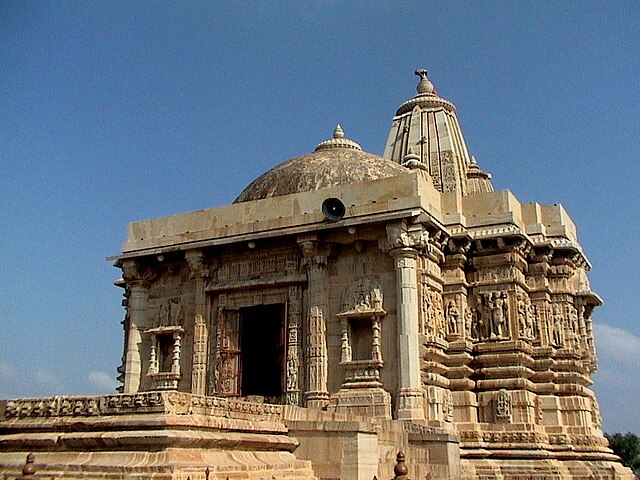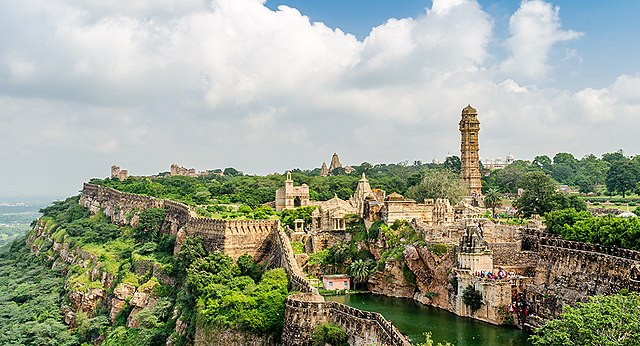Perched atop a rugged hill in the heart of Rajasthan, the Chittorgarh Fort stands as a colossal testament to the indomitable spirit of the Rajputs. Spanning 700 acres, it’s not just India’s largest fort but a living chronicle of bravery, sacrifice, and architectural brilliance. Imagine a fortress so grand that its walls whisper tales of epic battles, tragic love stories, and unyielding pride. Ready to step into a world where history breathes through every stone? Let’s embark on a journey through the Chittorgarh Fort, a UNESCO World Heritage Site that continues to captivate travelers, historians, and dreamers alike.
A Glimpse into Chittorgarh Fort’s Grandeur
Picture a fortress rising 180 meters above the plains, its silhouette dominating the skyline of Chittorgarh city. The fort’s sprawling complex, with a 13-kilometer perimeter, is a labyrinth of palaces, temples, and towers. Built in the 7th century, it served as the capital of the Mewar kingdom, a stronghold of the Rajput rulers. Its fish-shaped layout, when viewed from above, adds a whimsical charm to its formidable presence. But what makes this fort truly special? It’s the stories etched into its stones—tales of valor, love, and sacrifice that resonate even today.
Historical Significance of Chittorgarh Fort
Chittorgarh Fort isn’t just a structure; it’s a saga. Originally called Chitrakut, it was constructed by the Mori ruler Chitrangada Mori, though legends also tie its origins to Bhima, one of the Pandavas from the Mahabharata. The fort became the heart of Mewar under the Guhila dynasty, with Bappa Rawal capturing it in the 8th century. Over centuries, it faced three major sieges—each a chapter of courage and tragedy. From Alauddin Khilji’s conquest in 1303 to Akbar’s siege in 1568, the fort’s history is a rollercoaster of triumphs and heartbreaks.
The Siege of 1303: Alauddin Khilji and Rani Padmini
Ever heard of a love story that sparked a war? In 1303, Alauddin Khilji, the Sultan of Delhi, laid siege to Chittorgarh, allegedly smitten by the beauty of Queen Padmini. According to legend, he demanded to see her, but the Rajputs, protective of their queen’s honor, allowed only her reflection in a mirror. Deceived and enraged, Khilji captured the fort after an eight-month siege. The aftermath was tragic—Rani Padmini and thousands of women committed jauhar, a mass self-immolation to avoid capture. Was it love or ambition that drove Khilji? The debate continues, but the fort’s walls still echo this poignant tale.
The Siege of 1535: Bahadur Shah’s Conquest
Fast forward to 1535, when Bahadur Shah of Gujarat stormed Chittorgarh. The fort, under the Sisodia clan, faced another brutal siege. The Rajputs fought valiantly, but defeat loomed. Once again, the women of the fort chose jauhar, with 13,000 sacrificing themselves in a fiery act of defiance. The men, numbering 3,200, fought to the death. It’s like a phoenix rising and falling—Chittorgarh’s spirit never broke, even in defeat. This siege marked another chapter of Rajput resilience, a story that still inspires awe.
Akbar’s Siege of 1568: The Final Blow
In 1568, Mughal Emperor Akbar set his sights on Chittorgarh to subdue Mewar’s ruler, Maharana Udai Singh II. The fort’s defenders, led by Jaimal and Patta, put up a heroic resistance, but Mughal artillery proved too powerful. Udai Singh fled to the Aravalli hills, establishing Udaipur as the new capital. After the fort’s fall, another jauhar took place, cementing Chittorgarh’s legacy of sacrifice. In 1616, Emperor Jahangir returned the fort to the Rajputs, but its days as a capital were over. Can you imagine the courage it took to face such odds?
Architectural Marvels of Chittorgarh Fort

Beyond its history, Chittorgarh Fort is a treasure trove of Rajput architecture. Its 65 historic structures—including palaces, temples, and towers—showcase intricate craftsmanship. The fort’s seven massive gates, or pols, like Ram Pol and Suraj Pol, were designed to thwart invaders, with iron spikes and watchtowers adding layers of defense. Walking through these gates feels like stepping into a fortress frozen in time, each corner revealing a new marvel.
Vijay Stambh: The Tower of Victory
Standing tall at 37 meters, the Vijay Stambh, or Tower of Victory, is a masterpiece. Built by Rana Kumbha in 1448 to celebrate his triumph over Mahmud Khilji, this nine-story tower is adorned with carvings of Hindu gods and Jain deities, reflecting the Rajputs’ religious pluralism. Its 157 steps lead to breathtaking views of Chittorgarh city. At dusk, when the tower is illuminated, it glows like a beacon of pride. Ever climbed a monument that feels like a victory lap for an entire kingdom?
Kirti Stambh: The Tower of Fame
Not to be outdone, the Kirti Stambh, or Tower of Fame, is a 22-meter Jain monument built in the 12th century by a merchant named Jeeja Bhagerwala. Dedicated to Adinath, the first Jain Tirthankara, its seven stories are adorned with intricate carvings. Climbing its 54 steps is like unraveling a scroll of Jain heritage. The tower’s elegance contrasts with the fort’s ruggedness, proving Chittorgarh’s diversity in faith and art.
Rana Kumbha Palace: A Royal Abode
The Rana Kumbha Palace, built in the 15th century, is a blend of grandeur and decay. Its carved pillars and jharokha windows reflect Rajput opulence, while its ruined state tells of battles fought and lost. This palace, where Maharana Udai Singh was born, once housed stables and ornate balconies. Exploring its corridors feels like walking through a king’s dreams, now weathered by time. Can you hear the echoes of royal feasts and war councils?
Padmini Palace: A Tale of Beauty and Tragedy
The Padmini Palace, a three-story white edifice surrounded by a moat, is steeped in legend. This is where Alauddin Khilji glimpsed Rani Padmini’s reflection, sparking the infamous siege of 1303. Its canopied roofs and serene setting belie the tragedy it witnessed. Visiting the palace is like stepping into a love story tinged with sacrifice—a place where beauty and bravery collided.
Gaumukh Reservoir: The Lifeline of Chittorgarh
Ever wondered how a fort under siege survived for years? The Gaumukh Reservoir, fed by a spring emerging from a cow-shaped rock, was Chittorgarh’s lifeline. Capable of storing 4 billion liters, the fort’s 22 remaining water bodies (out of 84) ensured survival during prolonged sieges. The reservoir, near the Samidheshwara Temple, is considered sacred, its waters shimmering with history. Standing by it, you can almost feel the fort’s pulse.
Temples of Chittorgarh Fort: Spiritual Sanctuaries
Chittorgarh Fort is a spiritual haven, housing 19 temples, both Hindu and Jain. The Meera Temple, dedicated to the poet-saint Meera Bai, is a highlight. Her devotion to Lord Krishna, despite attempts on her life, is legendary. The Samidheshwara Temple, with its intricate carvings, and the Kalika Mata Temple, dedicated to Goddess Durga, add to the fort’s spiritual aura. These temples aren’t just places of worship; they’re time capsules of faith and resilience.
Jauhar Kund: A Symbol of Sacrifice
The Jauhar Kund is perhaps the fort’s most haunting site. Here, thousands of Rajput women performed jauhar, choosing death over dishonor. Though not open to the public, its presence is a somber reminder of the price paid for pride. Visiting nearby sites, marked by information boards, feels like paying homage to these brave souls. How does one comprehend such sacrifice?
Visiting Chittorgarh Fort: Practical Tips

Planning a trip to Chittorgarh Fort? It’s open daily from 9 AM to 6 PM, with entry fees of ₹40 for Indians and ₹600 for foreigners. The fort’s vast size means you’ll need 3-4 hours to explore, so wear comfortable shoes and carry water. Hiring a licensed guide is a game-changer—they’ll bring the fort’s stories to life. The Light and Sound Show, held at dusk (English on Fridays, Hindi otherwise), costs ₹100-200 and is a must-see for its vivid storytelling.
How to Reach Chittorgarh Fort
Chittorgarh is well-connected by road and rail. The nearest airport is in Udaipur, 120 km away, with cabs and buses readily available. Chittorgarh Junction, the city’s railway station, links to major cities like Delhi and Jaipur. From the station, auto-rickshaws or taxis can whisk you to the fort. The best time to visit? October to March, when Rajasthan’s weather is pleasantly cool, perfect for exploring this historic gem.
Exploring Beyond the Fort
Chittorgarh city offers more than just the fort. Visit the vibrant Fort Road Market for Thewa jewelry, bandhani textiles, and Rajasthani souvenirs. For nature lovers, the Sitamata and Bhainsrodgarh Wildlife Sanctuaries are nearby. Craving local flavors? Try Dal Baati Churma or Lal Maas for a taste of Rajasthan’s culinary soul. The city’s blend of history and culture makes it a perfect extension of your fort adventure.
The Legacy of Chittorgarh Fort

Chittorgarh Fort isn’t just a monument; it’s a symbol of Rajput valor and sacrifice. Its walls have witnessed love, war, and resilience, making it a pilgrimage for history buffs and romantics alike. The fort’s designation as a UNESCO World Heritage Site in 2013 underscores its global significance. Whether you’re marveling at the Vijay Stambh or reflecting at the Jauhar Kund, Chittorgarh leaves an indelible mark. It’s like a book you can’t put down—each chapter more gripping than the last.
Conclusion
Chittorgarh Fort is more than a destination; it’s a journey through time. Its towering gates, majestic palaces, and sacred reservoirs tell a story of a people who valued honor above all. As you walk its winding paths, you’ll feel the weight of history and the thrill of discovery. Whether you’re drawn by tales of Rani Padmini, the architectural splendor, or the sheer scale of this 700-acre marvel, Chittorgarh Fort promises an experience that lingers long after you leave. So, pack your curiosity and step into Rajasthan’s beating heart—Chittorgarh awaits.
Frequently Asked Questions
1. What is the best time to visit Chittorgarh Fort?
The ideal time is October to March when the weather is cool, with temperatures between 15°C and 25°C, making exploration comfortable.
2. How long does it take to explore Chittorgarh Fort?
You’ll need 3-4 hours to cover the fort’s major attractions. Its vast size and numerous structures require ample time and comfortable footwear.
3. Is the Light and Sound Show at Chittorgarh Fort worth it?
Absolutely! The show, held at dusk, brings the fort’s history to life with stunning visuals and narration, costing ₹100-200.
4. Can I take my car inside Chittorgarh Fort?
Yes, vehicles are allowed for a fee (₹50 for cars). However, walking or hiring a guide is recommended to fully appreciate the fort’s details.
5. Are there any nearby attractions to visit after Chittorgarh Fort?
Explore the Fort Road Market for souvenirs or visit the Sitamata and Bhainsrodgarh Wildlife Sanctuaries for a dose of nature.

